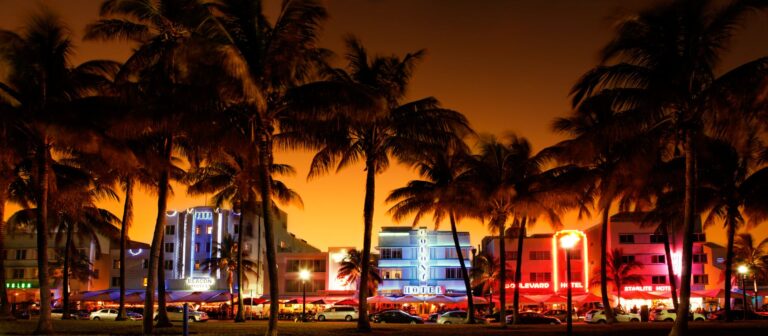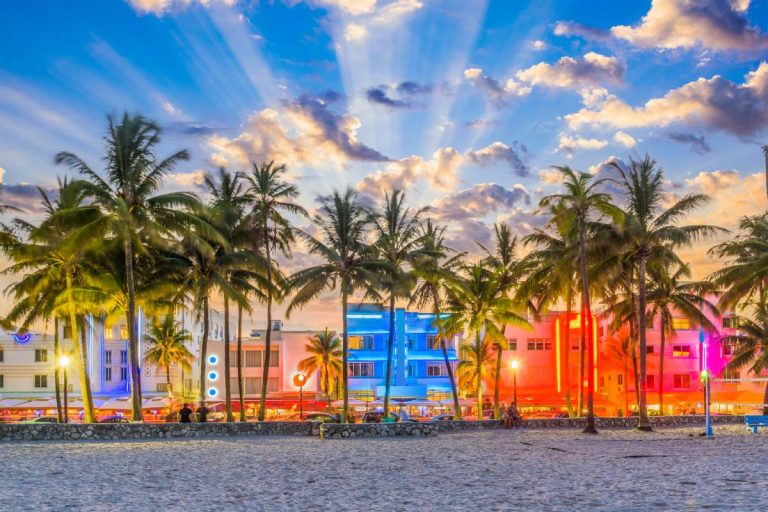It begins with the soft beat of the bongos, the two drums connected to each other. After a while, maracas and the güiro, a percussion instrument made from a calabash, join in. The evening has only just begun, but it is already difficult to get a table at Cuba Ocho. Located on the main street, Calle Ocho, this is one of the most popular clubs in Little Havana. Tourists and regulars come for the concerts, to drink mojitos and cuba libres, to view the paintings by Cuban artists hanging on the walls, near the ceiling, painted on the table tops. “Art is literally everywhere! It is there to be enjoyed!” says Roberto Ramos, Cuba Ocho’s owner.

By boat and on rafts
In 1992, at the age of just 17, Roberto Ramos sailed from Havana to the coast of Key West, Florida. He was just 90 miles from his dream life in the USA and one of hundreds of thousands of Cubans (no one knows the exact number) who have tried to reach the United States by sea over the years. Roberto sailed on a fishing boat with his first small art collection hidden below deck, while others sailed on rafts made of planks, polystyrene and tractor inner tubes – sometimes even surfboards. Many of them settled in Little Havana, a neighbourhood born out of homesickness for the real thing, the taste of sweet mangoes and fried cassava mingling with the garlic, herbs and oil scent of mojo verde sauce.
Visit the city where hearts beat to the rhythm of Son Cubano
I did not want to live in slavery
Miami is one of the most Hispanic-populated cities in the United States. People of Hispanic origin make up about 70% of the total population, and it is often easier to communicate in Spanish in a shop or taxi than in English. Among the Mexicans, Dominicans and Guatemalans, Cubans are the most numerous group. Not all have sailed across the sea like Roberto; some have flown here at the invitation of family, while many more have crossed the US-Mexico land border. Whether legally or clandestinely, depending on the migration policies and decisions of successive US presidents, Cubanshave been leaving since the revolution, when Fidel Castro took power of the island in 1959.
At first it was the political opponents of the revolution who left, but over time they were joined by those who simply wanted a better life, to earn something, not to spend hours in queues in shops, not to worry about every peso they spent. Why did Roberto decide to leave Cuba? “I didn’t want to live in slavery. And until Cuba is free, I will not go back,” he says. In Miami, he has a mission to fulfil. He is restoring the memory of Cuban artists erased by the regime. Cuba Ocho is a place with atmosphere, with furniture bought from Frank Sinatra’s former bar. Ramos also buys, displays in his club gallery and sells the paintings of those Cubans who did not get on with Fidel Castro. Even today, in Cuba there is only room for painters, writers and musicians who do not criticise the authorities.


Dominoes full of emotion
You don’t have to wait until nightfall to visit Little Havana. Calle Ocho is alive with dancing in the evenings and also by day. In Maxim Gomez Park, older, festively-dressed Cubans gather to play dominoes. It’s their national game, and although it’s hard to believe, it can cause real excitement in both players and observers. Played by four people in pairs, a double tap of the fingers on the table means you have no more dominoes to add. Here at Gomez, everyone is in shirts or neatly pressed dresses, as if they were going to a party. Many have cigars in their mouths, another Cuban characteristic. Coffee and cigars are symbols of the island, and you cannot miss them in Little Havana. Coffee is drunk black, strong and sweet. Preferably after each meal, which in this part of Miami is, of course, prepared in the Cuban way.

Under the Versailles window
I start with fufú, a puree made from boiled bananas, and the main course is one of the most traditional Cuban dishes – ropa vieja. Literally translated, the name of the dish means ‘old clothes’, and it consists of long-cooked jerk beef in a wine and tomato sauce. It is served with rice and black beans, perhaps with fried manioc or the potato-like malanga. Versailles is a famous restaurant in Little Havana that serves traditional Cuban food. However, it cannot be said that the food is the same as on the island. Beef has not been eaten in Cuban homes for years, and fish is in short supply. The island’s crisis, which is getting worse by the month, is also visible on its plates, therefore Miami is a reminder of what used to be eaten on the island.
As well as its delicious food, Versailles is also famous for its ‘window’. This is where Cubans buy their takeaway coffees and have political discussions about what is happening on the island, new ideas and restrictions by the Cuban government, repression and arrests. Sometimes the conversation turns to political life in Miami, but their emotions are mainly stirred by what is happening in the country they have left.

A city for life
The second, more formal centre of Cuban exiles’ political life is the Bay of Pigs Invasion Museum, usually referred to as the House of Brigade 2506, and I am shown around by one of the veterans, Aurelio Pérez-Lugones. In April 1961, a group of Cuban exiles, supported by the CIA and the US government, invaded their own country. Their aim was to start an anti-Castro uprising on the island and overthrow the revolution. The invasion failed, however, and most members of Brigade 2506 were taken prisoner. After more than a year and a half, the Cuban government agreed to transfer the prisoners to the US in exchange for $53 million worth of food and medicine.
“I was on the last plane to leave Cuba. We were greeted in Miami by President Kennedy,” recalls Pérez-Lugones, continuing, “After the defeat at the Bay of Pigs, no one saw an alternative to the revolution; in the eyes of Latin America, Castro was the David who had smitten Goliath.” he concludes. From then on, he knew that Miami would be his home – not just for a while, but perhaps for a lifetime. In the museum, I look at memorabilia and archive photographs and see where veterans hold meetings and conferences. In Little Havana Memorial Park there is always a fire burning, and the plaque reads ‘In honour of our veterans’.
Discover Miami on your own
Angela seeks her place in Miami
Not all of Miami lives for politics. Some people have no interest in it at all. “They just come here to have a better life, to follow their dreams,” explains Angela, who has only lived in the US for a year. In Cuba, she worked in tourism, which meant she didn’t earn too badly. Cubans in government jobs make up the majority of the population and earn about $30 a month. By working in tourism, they have the opportunity to earn more. But after the global pandemic, tourism on the island is yet to fully recover.
Angela became increasingly frustrated and finally decided to leave. She managed to get to the United States via Mexico, though she prefers not to divulge the details. Today, she drives a taxi around the city. She drives through Little Havana to the coast and the wide, sandy beaches of South Beach and Miami Beach. It runs to the wealthy Coral Gables neighbourhood, developed in the 1920s, and to the skyscraper-filled Brickell district. Shealso visits Little Haiti and Little Santo Domingo, populated by newcomers from the Dominican Republic. Shesees a Miami made up of different cultures, sounds and traditions, different dreams and memories.





